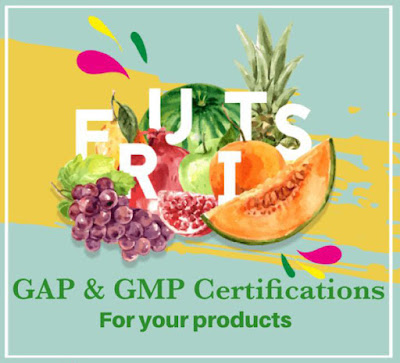GAP (Good Agricultural Practices)
Global G.A.P. is a private sector organisation that develops and establishes voluntary standards for the certification of agricultural products around the world. Their mission is to establish a set of standards that:
- Facilitate Good Agricultural Practices.
- Minimize the detrimental effects of farming operations on the environment.
- Aim at reducing the use of chemical usage.
- Ensures the safety of agricultural workers as well as animals.
- Ensures that vegetables and fruits are produced, packed, handled, and stored as safely as possible in order to minimize risks of food contamination by microbial organisms.
Good agricultural practices refers to the basic environmental and operational conditions necessary for the production of safe, wholesome fruits and vegetables. They are actions taken by produce farmers to reduce the risk of microbial contamination in their farm products.
What are the Good Agricultural Practices?
- Buying animals of known disease status only and control their introduction into the farm.
- Making sure the transportation of animals on and off the farm does not introduce diseases.
- Using chemicals according to directions or as instructed by chemist.
- Using veterinary medicines as prescribed by veterinarians only when treating animals.
- Making sure the nutritional needs of animals are met.
- Making sure that the water used is from a good safe source.
- Ensuring proper disposal of waste.
- Ensuring that the packing and refrigerators are well maintained and not a potential source of contamination.
- Download the GLOBAL G.A.P. Standard documents and checklists that valid for your farm or product from GLOBAL G.A.P’s Document Centre.
- Search available G.A.P certification organisations in your country and select one.ou can find a full list of GLOBAL G.A.P. approved certification bodies on the GLOBAL G.A.P’s Certified Bodies page. Register there and you will get a GLOBAL G.A.P. Number (GGN).
- Do a self-assessment using the checklist you obtained and correct all the standards you do not comply with. You may get assistance from a GLOBAL G.A.P. licensed farm assurer.
- Schedule an appointment with the GLOBAL G.A.P. approved certification body that you chose, and an inspector will then conduct the first on-site inspection.
- Once you are successful, meaning you comply with all the standard’s requirements, you will receive a GLOBAL G.A.P. Integrated Farm Assurance Standard Certificate for the relevant version and scope which is valid for one year.
Good Manufacturing Practice (GMP)
Good Manufacturing Practice (GMP) is a
system of processes, procedures, and documentation that facilitates production
of quality products all over the globe. It makes sure that such products are consistently
produced.
GMP takes into consideration all the
aspects of production of a product, from its raw materials, premises, and
equipment to the training and personal hygiene of staff. It consists of detailed
written procedures which are essential for every process that could affect the
quality of the finished product.
GMP’s mission
- Outline a quality system that reduces or prevents errors.
- Ensure products are safe.
- Prevent and better manage contamination and cross-contamination.
- Prevent false information, mislabeling and adulteration.
- Provide a better understanding and comply with the relevant laws and regulations.
- Enhance the international credibility and public image.
These GMP guidelines and regulations ensures that manufacturers, processors, and packagers of drugs, medical devices, and food take proactive measures to ensure that their products are safe, pure, and effective. GMP guidelines and regulations outlines a number of issues that can influence the safety and quality of a product. some these guidelines are;
Hygiene: Production institutions must maintain a clean and hygienic manufacturing area. There should be a proper cleaning mechanism and waste disposal method.
Controlled Environmental Conditions: You must Prevent product contamination and cross contamination from outside.
Manufacturing processes: All the manufacturing processes should be closely monitored for errors, defined well, and controlled.
Instructions and procedures: All instruction should be mentioned clearly, and Straightforward. Otherwise some miscommunication may occur and that is not good for the process.
Operators: Adequately trained to carry out works and document procedures.
Records that demonstrate compliance: All the safety, cleaning, operations and other process should be recorded during manufacturing process either manually or by machines/software. This will help to understand the errors and and trends.
Details of the manufacturer: (including distribution) that enable the complete history of a batch to be traced are retained in a comprehensible and accessible form.
The distribution of the products: This is not significantly affect to the quality. How ever it is helpful to recall any batch of the product due to error or quality issues.
Complaints: All the complaints are examined and investigated, and appropriate measures are taken with respect to the defective products and to prevent recurrence.










No comments:
Post a Comment